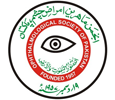ISSN 0886-3067



Volume No 35 Issue No 3
Difference in Central Corneal Thickness between Applanation Ultrasound and Oculus Wave … 152 Light Occulyzer II
Purpose: To determine the mean difference of central corneal thickness measurements by using ultrasound Pachymetry and oculus Wave light Occulyzer II. Study Design: Cross-sectional comparative study using non-probability consecutive sampling. Place and Duration of Study: This study was conducted at Department of Ophthalmology, Liaquat National Hospital Karachi from November 2018 to June 2019. Material & Methods: After approval from ethical committee, patients were included in our study on the basis of inclusion & exclusion criteria. Central corneal thickness measurements were taken by using ultrasound Pachymetry & oculus Wave light Occulyzer II. All the data was collected by single researcher. The results were plotted, compared & analyzed. Paired t-test was used for the comparison of quantitative variables. Results: There were 130 patients included in the study out of which 73 (56.2%) were males and 57 (43.8%) were females. Mean age of these patients was 33.9 ± 8.9 years. The mean ± SD thinnest oculus Wave light Occulyzer II measurement was 538.61 ± 23.46 ?m and ranged between 476.0 and 619.0 ?m whereas the mean thinnest ultrasound Pachymetry measurement was 535.1 ± 21.816 ?m and ranged between 482 and 601 ?m. There was highly significant correlation of central corneal thickness between both the instruments. (r = 0.96, p < 0.001). Conclusion: There is a high correlation of central corneal thickness between the readings obtained from ultrasound and optical pachymetry machines therefore oculus Wave light Occulyzer II can be used as an alternative technique to ultrasound pachymetry while assessing CCT in clinical settings. Key Words: Central corneal thickness, Ultrasound Pachymetry, Optical Pachymetry.
HTML Full Text | Complete PDF